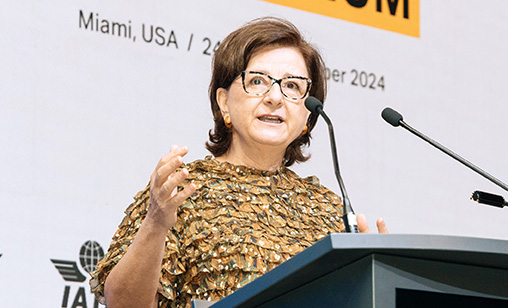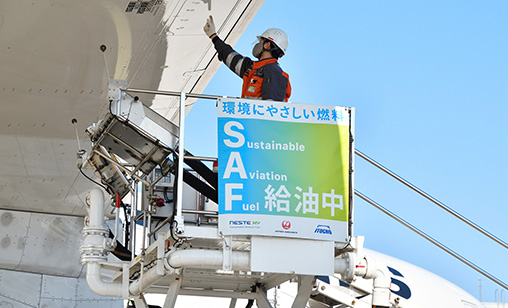Industry Insight Special Report
Plodding SAF production to pick up pace
Finally, convincing governments, private investors and industry partners to commit to Sustainable Aviation Fuel (SAF) production is making head way. Associate editor and chief correspondent, Tom Ballantyne, reports.
October 1st 2024
New data from the International Air Transport Association (IATA) has detailed the staggering cost required to output sufficient Sustainable Aviation Fuel to hit the industry’s net zero 2050 emissions target. Read More »
Averaged annual investment necessary to fund SAF production in the next three decades is estimated at approximately $128 billion per annum - in a best case scenario. Annual transition costs for jet fuel, hydrogen and other key levers on top of that amount are calculated at $1.4 billion and that is only in 2025.
 |
In 2050, transition costs could be as high as $744 billion, based on IATA’s analysis. These huge numbers highlight the need for speed and scale in bringing solutions to market to achieve net zero CO₂ emissions within the industry’s time frame, IATA said.
Speaking at IATA’s World Sustainability Symposium (WSS) in Miami in late September, the global airline association’s senior vice president sustainability and chief economist, Marie Owens Thomsen, said: “The costs and challenges associated with the energy transition are large, but the opportunities are even greater.
“Countries have an opportunity to build new industries in agriculture and energy and to benefit from the catalytic growth of sustainable air transport.
“To realize the opportunities, all minds need to unite in this mission and all policymakers, multilateral organizations, investors, solution providers and the air transport industry must work together.
“Such transformative collaboration can pool resources and target meaningful action for greater impact. It is needed to deliver a sustainable air transport industry by 2050.”
IATA’s updated Policy and Finance Net Zero Roadmaps, released in Miami and containing expanded and deepened analyses, draws four conclusions:
* The air transport industry’s energy transition is feasible on the 2050 horizon.
* Investment to make that possible is comparable to those enterprises engaged in previous creations of new renewable energy markets.
* Successful transition depends on unity of purpose of policymakers.
* Time left for joining forces in air transportation’s energy transition is shrinking by the minute. Every action delayed is an opportunity missed.
“The updated IATA Policy and Finance Net Zero Roadmaps make it clear de-carbonization by 2050 is possible,” IATA director general, Willie Walsh, said.
“They also sound a warning bell. To achieve these targets, all stakeholders, particularly policymakers, must collaborate more broadly and act with greater urgency.
“To be successful, we need clear policy and financial frameworks to support air transportation that is realistic and coherent for the massive changes that must take place simultaneously in all economic sectors.”
 |
There are signs of progress. Last month, a landmark ministerial conference in New Delhi resulted in 29 Asia-Pacific nations committing to sustainable aviation.
The high level Delhi Declaration set ambitious targets for SAF in a time of fast growth in Asia-Pacific aviation.
“This declaration is a roadmap for the future of aviation in one of the world’s fastest-growing regions,” ICAO council president, Salvatore Sciacchitano, said.
“It demonstrates a collective will to embrace innovation while prioritising safety, security, and environmental responsibility.”
Several nations in the region have roadmaps to aviation sustainability, including Japan, where the government has stated 10% of aviation fuel used for international flights out of Japan’s airports will be SAF powered by the end of the decade.
In April last year, locally blended SAF was produced for the first time in Japan. It was purchased by All Nippon Airways and Japan Airlines and its production development sponsored by the Japanese government.
India has a SAF roadmap under development and some of the country’s airlines have tested SAF blends. Recently, Vistara operated its first long-haul SAF flight out of India.
In September last year, Thai Airways International said it will increase its SAF use from 2% in 2025 to 60% by 2050. Bangchak, a petroleum and energy conglomerate in Thailand, will open a production plant by year-end to convert used cooking oil to SAF.
Further south, Singapore Airlines is partnering with the country’s government in a pilot SAF credits scheme. Neste started SAF production in Singapore in May last year. In the same month, Jet Aviation announced a partnership with FlyORO, a fuel blending services provider, to offer SAF blends in Singapore.
In June 2023, following a one-year programme run by Air New Zealand, the carrier and the government committed NZ$2 million to continue investigating the possibility of SAF production in New Zealand.
Across “the ditch”, a SAF roadmap is being developed jointly by the Australian government, Boeing and Australia’s National Science Agency. In 2023, LanzaJet announced a feasibility study for an Alcohol-to-Jet facility in Queensland.
It is being supported by Queensland’s state government, Qantas Airways and Airbus in a multi-million dollar joint program.
Australia has not announced specific SAF targets, but Qantas Group is planning for SAF to account for 10% of its fuel needs by 2030.
South Korea intends to introduce a SAF mandate by 2026 and Indonesia has said it will legislate a 5% SAF mandate from next year.
Still, when looking into SAF agreements in the region, SAF demand is likely to fall short of government targets.
The only transaction that stands out in the region is the 76 million gallons offtake agreement with Kuala Lumpur International Airport starting in 2027.
ING data shows the Asia-Pacific is capable of producing more than 1.8 million tonnes (Mt) of SAF, equivalent to less than 1.5% of jet fuel use in the region.
SAF production capacity is predicted to increase to 1.8 Mt in 2025, reaching as much as 5.1 Mt by 2030; 4.2% of jet fuel demand.
ING also noted some SAF facility projects have been cancelled. It cited Shell’s bail out from a biofuel plant in Singapore and Oceania Biofuels cancellation of a SAF project in Australia.
Nevertheless, “Big Four” consultancy, KPMG, wrote the more favorable local policy environment in the Asia-Pacific is encouraging SAF development in the region.
“As a result, airlines, airports, investors and fuel producers increasingly are making public commitments to growth of local SAF supply and demand, KPMG said.
“However, with inherent feedstock limitations and challenges in scaling up to more advanced SAF production pathways, the development of a SAF industry in the Asia-Pacific has the potential to both accelerate and hinder SAF progress in the West.”
KPMG suggests SAF activity could boom in China in particular. Until early 2023, the only notable SAF production facility in China was Sinopec’s outer Shanghai plant. It delivers fuel to the Airbus Delivery Centre in Tianjin.
But in April last year, the Cathay Group committed to developing four power-to-liquid production facilities in China alongside the State Power Investment Corporation, one of the five large state-owned energy companies in China.
“China’s track record in rolling out wind and solar energy, as well as transport infrastructure more widely, has demonstrated its ability to move quickly when it decides to adopt a technology solution,” KPMG said.
“If the four facilities, backed by the government, are brought on line to 2026, commercial SAF production in China could kick start ahead of European countries where approaches to SAF incentives are still being refined.”
Peking University’s Institute of Energy estimated China could increase SAF production by around two million tons by 2025 if existing production of hydrotreated vegetable oil, used for road transport, is switched to SAF.
To date, China has the largest planned SAF capacity, accounting for around 43% of planned capacity in the region by 2030.
In the midst of this complicated growth trajectory, IATA continues to advocate means to increase SAF usage.
In Miami, it announced it will launch the Sustainable Aviation Fuel (SAF) Matchmaker, linking airlines and SAF suppliers, in the first quarter of next year.
“Our vision is to create a transparent, efficient and accessible matchmaking platform to accelerate the uptake of SAF as the aviation industry progresses towards net zero CO₂ emissions by 2050,” IATA said.
“The platform will do that by reducing the costs and complications airlines face when looking for SAF suppliers.
| Emissions from flying decline but stalled aircraft deliveries hinder progress to 2050 targets Data released by aviation market intelligence and advisory company, IBA, shows a significant global decrease in CO₂ per Available Seat Kilometre (ASK) compared with pre-pandemic levels. There has been a major improvement in global aircraft efficiency with CO₂ per ASK declining between 4.1% and 10.1% from 2019 to 2024 as airlines introduce more efficient aircraft into their fleets, IBA wrote. However, the recovery from the global pandemic has exposed regional variations in flight efficiency. The Asia-Pacific has recorded the smallest improvement, of 4.1%, from an average of 91.8g CO₂ per ASK in 2019 to 88.1g in 2024. Latin America is at the forefront of the change with a 10.1% improvement of 90.9g of CO₂ emissions per ASK in 2019 to 81.7g in 2024. In Europe, emissions fluctuated in the five years, but ultimately recorded a 6.9% reduction in 2024 compared with 2019, slowing from 90.5g in 2019 to 84.3g in 2024. IBA ESG manager, Jennifer Staley, said: “IBA’s latest data demonstrates aircraft fuel efficiency is improving as a result of better technology and operational practices. However, discrepancies exist between countries due to varying investments in new aircraft, regulatory environments and economic factors.” The data was collected by IBA’s NetZero platform, including its IBA NetZero Reporting tool, an extension of IBA NetZero. “The platform allows users to maintain an exposure portfolio over time by easily and reliably accessing emissions reports at the airline, lessor, aircraft or fleet/portfolio level using a wide variety of measurement metrics,” IBA said. Although airlines in the Asia-Pacific have hundreds of new fuel efficient aircraft on order, their acceptance into the region’s fleets has been slowed by supply chain unreliability and delayed deliveries. Analysts suggest these factors are the main reasons the Asia-Pacific lags behind the rest of the world in reducing emissions from flying. |